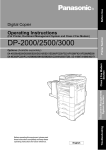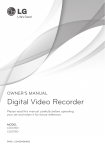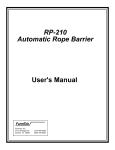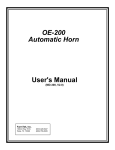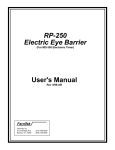Download UNPACKING THE TIMER THE TIMER CONSOLE Turning on the
Transcript
MD-200 User's Manual
Page 1
Congratulations on your purchase! Your new timer
should provide years of trouble-free service. To maximize
the performance and life of your timer, please read this
user's manually carefully before using your timer. It is
important to familiarize yourself with the timer before attempting to use it at your first event.
Page 2
MD-200 User's Manual
timer console and then plug the adapter into a wall
plug. A rear view of the timer console illustrating
the position of the POWER jack is shown below:
RECEIVER
HORN
DISPLAY
POWER
UNPACKING THE TIMER
Your new timer comes in a protective carrying
case. Inside the case you'll find the following
items:
•
•
•
•
•
•
Timer console ("MD-200 Electronic Timer")
Infrared light source ("Transmitter")
Infrared light detector ("Receiver")
Camera tripods (2)
125 foot cable
AC power adapters (2)
Location of POWER Jack
As soon as the timer console is plugged in, the unit
is on and the display reads "0.000". Now we're
ready to push some buttons!
The START/STOP Button
THE TIMER CONSOLE
The timer console is the "heart" of your new timer
system. The front of the timer console has four
push-buttons for controlling the timer, and a six
digit time display. The back of the timer console
has four jacks for connecting power, the light detector, an optional scoreboard display, and an optional horn. These connections are each discussed
in detail in later sections.
The best way to learn about your new timer is to
use it. Try each of the operations outlined in the
following sections as you read through the manual.
The START/STOP button is used to manually start
and stop the timer. When the timer is started, the
time is first reset to zero, and then the running
time is shown on the display. When the timer is
stopped, the final time is shown on the display.
If the timer is not running, pressing the
START/STOP button starts the timer. If the timer
is running, pressing the button stops the timer.
Even if the timer was started by breaking the light
beam, it can be stopped with the START/STOP
button, and vice-versa.
The RESTART Button
Turning on the Timer Console
The timer console must be plugged into a standard
wall outlet to operate. Using either of the AC
power adapters provided (they're identical), insert
the small plug into the POWER jack on the rear of
the
Whenever the timer is stopped via the START/STOP
button or by breaking the light beam, the final time
is shown on the six digit display. However, the
timer continues to count "inside." So even though
the final time is shown on
MD-200 User's Manual
Page 3
the display, the timer is still counting as if it were
never stopped!
Pressing the RESTART button allows you to resume timing on the display. Since time was kept
internally while the display was "frozen", the time
on the display now reads as if the timer was never
stopped. Obviously, the RESTART button works
only if the timer is stopped.
Imagine the following: A rider speeds through the
light beam to start the timer. Unfortunately, her
hat blows off and falls through the light beam and
stops the timer! Normally, the rest of her ride is
wasted, but by pressing the RESTART button, her
timing can be resumed as if the timer were never
stopped!
Since you can resume timing via the RESTART
button, you no longer have to worry about false
triggers – you can even purposely stop the timer to
measure "split" times or to check a previous time!
(See next section.)
The PREVIOUS TIME Button
Have you ever missed recording a time because the
next rider started the timer before you wrote the
original time down? Or maybe someone walked
through the light beam, or a piece of paper blew
across and started the timer – erasing the time of
the last ride. Well, that's not a problem anymore.
The PREVIOUS TIME button allows you to recall the
previous rider's time!
The timer must be stopped to look at a previous
time. Simply press the PREVIOUS TIME button and
hold the button down. The previous time is displayed as long as the button is held down. Release
the button and the most recent time is restored.
Page 4
MD-200 User's Manual
For example, let's say the next rider has started the
timer before you recorded the last rider's time.
Simply wait until the new rider is done, and then
display the previous rider's time by pressing the
PREVIOUS TIME button. If you don't want to wait,
stop the timer immediately by pressing the
START/STOP button (don't worry, we won't lose the
current rider's timing!). Then press the PREVIOUS
TIME button to view the previous rider's time. After
recording the time, continue timing on the current
rider by pressing the RESTART key.
The ALIGN Button
To work properly, the infrared light source (transmitter) and infrared light detector (receiver) must
be properly aligned. (Alignment of the electric eyes
is discussed in detail in a following section.)
The alignment of the electric eyes can be checked
by pressing the ALIGN button any time the timer is
stopped. If the "eyes" are properly aligned, "Good"
is displayed. If not properly aligned, "bAd" is displayed. If the display alternates between "Good"
and "bAd", assume the alignment is bad. To return
to normal operation, press the ALIGN button again.
The HORN Jack
A HORN jack is provided on the rear of the MD-200
timer console. This jack allows connection of the
optional "OE-200" horn. This horn automatically
sounds at any time you specify. Details about
connecting and operating the horn are in the user's
manual provided with the horn.
The horn jack is also used to connect a remote barrier release for the optional "RP-200" roping package. The roping package automatically starts the
timer and releases the barrier in front of the
MD-200 User's Manual
Page 5
rider when a calf or steer breaks the light beam
between the MD-200 electric eyes. Details about
connecting and operating the roping package are in
the user's manual provided with the roping package.
The DISPLAY Jack
A DISPLAY jack is provided on the rear of the MD200 timer console for connection to the OE-250
scoreboard display. The MD-200 also supports
scoreboards from several other manufacturers –
contact FarmTek for additional information. The
running and final times are displayed on the
scoreboard. Details about connecting and operating the scoreboard display are in the user's manual
provided with the scoreboard.
Page 6
MD-200 User's Manual
THE ELECTRIC EYES
The infrared light source (transmitter) and infrared
light detector (receiver) are mounted on tripods on
opposite sides of the arena. When the light beam
between them is broken, the timer is either started
or stopped. As with the START/STOP switch, if the
timer is not running, breaking the beam resets the
time to zero and starts the timer. If the timer is
running, breaking the beam stops the timer – the
final time is shown on the display.
When the beam is broken, the timer console
"beeps" to alert you about the trigger. After the
beam is broken, the timer ignores additional beam
breaks for two seconds. This prevents multiple
triggers such as starting the timer with the horse's
front legs, and then immediately stopping the timer
with the horse's hind legs!
The receiver is connected to the main timer console
via a 125 foot cable. This cable is used to signal
the main timer console when the light beam is broken. The transmitter needs no connection to the
timer console. A typical arena set-up is shown below:
Arena
Transmitter
Entry
Chute
Receiver
125'
Cable
Console in
Announcer's
Stand
MD-200 User's Manual
Page 7
Infrared Light Source - Transmitter
The transmitter unit is labeled "TRANSMITTER" on
its rear panel. The transmitter outputs the infrared light beam that is detected by the receiver. The
infrared light is emitted through the solid black
front panel. The transmitter has built in rechargeable batteries to allow operation in the arena without AC power. However, if by mistake the batteries
were not charged, the transmitter can be operated
by plugging it in.
The transmitter must be switched "ON" to operate.
If an AC power adapter is plugged into the transmitter, the unit runs from AC power. If no AC
adapter is inserted, the unit runs from its internal
batteries. When not in use, the transmitter must
be switched "OFF". Over-discharge of the batteries
can damage them.
NOTE:
If by mistake the batteries are severely
discharged, it may take several minutes
before the transmitter operates properly
even after the AC adapter is plugged in.
Charging the Batteries
After a full battery charge, the transmitter will operate about ten hours. Typically, this is enough
time to use the transmitter on two or more separate occasions before recharging is necessary. In
fact, it is actually better for the batteries to be used
for six to ten total hours before recharging, rather
than just a few hours – as if recharged after each
use.
To recharge the transmitter, plug it into a wall
outlet using either of the AC power adapters provided for about 14 hours. (Always insert the plug
into the transmitter first, and then plug the other
end into the wall outlet.) Make sure the unit is
"OFF" when recharging. Do not leave the transmitter charging for a single period of more than 14
hours.
Page 8
MD-200 User's Manual
After charging, the transmitter will remain almost
fully charged for several weeks if stored at room
temperature. If not used for two or more months,
recharge the batteries over-night before the next
use.
Infrared Light Detector - Receiver
The receiver unit is labeled "RECEIVER" on its rear
panel. The receiver detects the infrared light beam
emitted by the transmitter. The infrared light
passes through the solid black front panel.
The receiver is connected to the timer console by
the 125 foot cable provided. This cable provides a
signal to the timer console when the light beam is
broken. To connect the cable, insert either end
into the jack labeled CONSOLE on the rear of the
receiver unit. Insert the other end of the cable into
the jack labeled RECEIVER on the rear of the timer
console. Make sure the plugs are fully inserted.
These connections should be made with the timer
console "OFF". A rear view of the timer console illustrating the position of the RECEIVER jack is
shown below:
RECEIVER
HORN
DISPLAY
Location of RECEIVER Jack
POWER
MD-200 User's Manual
Page 9
Tripods
For use in the arena, the electric eyes should be
mounted on the tripods provided. As you read this
section, try the adjustments mentioned to familiarize yourself with the tripods.
The tripod has latches on its legs to adjust them to
the desired length. Open the latch to extend or
shorten a leg, then close the latch to lock the leg in
place. Do not over-tighten "twist" type leg latches!
Near the top of the tripod where the three legs
come together, a center tube (neck) can be raised
or lowered to further adjust the height of the tripod. Loosen the collar latch by turning it counterclockwise, and then raise or lower the neck as desired. After adjustment, tighten the collar latch by
turning it clockwise.
The very top of the tripod is called the "head". Two
adjustments allow the head to turn left to right,
and to tilt forward and backward. The long handle
is used to adjust the forward and backward tilt.
Turn the handle counter-clockwise to loosen, and
then use the handle to adjust the tilt. Turn the
handle clockwise to tighten the head in the new
position. The knob at the very top of the neck can
be loosened to allow you to move the head left and
right. Turn the knob counter-clockwise to loosen,
clockwise to tighten.
A 1/4 inch screw protrudes through the top of the
head. To mount the receiver or transmitter to the
tripod, position the hole on the bottom of either
unit over this screw. Turn the knob under the
head counter-clockwise (when viewed from the top)
to tighten the screw into the receiver or transmitter. Tighten the screw firmly, but do not overtighten. Turn the knob clockwise to loosen the
screw and remove the receiver or transmitter.
Align the unit on the tripod such that the long tripod handle extends towards you and the rear of
the unit faces you.
Page 10
MD-200 User's Manual
Aligning the Electric Eyes
The infrared light from the transmitter is emitted
in a very narrow beam. This beam must be
"aimed" at the receiver to ensure that the receiver
"sees" the light beam. The infrared light is emitted
and received through the solid black panel on each
unit – this is the front of the unit. Read the tripod
section to familiarize yourself with the tripods before attempting to set up and align the transmitter
and receiver.
To set up the electric eyes in the arena, first attach
the transmitter and receiver to the tripods as detailed in the tripod section. Then adjust the tripods to the desired height. The eyes should be
high enough so that the light beam is broken by
the horse's body (not the legs).
Next, place the eyes on opposite sides of the arena.
The eyes should be separated by about 50 to 175
feet. Aim the transmitter in the general direction
of the receiver and vice-versa. Then, complete final
alignment as described below:
Carefully align the transmitter. Left-to-right
alignment can be checked by looking down either
line on the top of the transmitter. The line should
point straight at the receiver. Up-and-down alignment of the transmitter is checked by looking down
the crack on the side of the unit. Adjust the tilt
such that the receiver is directly in line when
looking straight down the crack on the side of the
transmitter. When tightening the tripod adjustments after the alignments are made, make sure
the alignment is still good – tightening the tripod
knobs may move your previous adjustment.
Alignment of the receiver is not critical. It just
needs to be pointed – both horizontally and vertically – in the general direction of the transmitter.
MD-200 User's Manual
Page 11
To check the alignment, follow the procedures outlined previously to turn on the transmitter and
connect the receiver to the timer console. Then
turn on the timer console and press the ALIGN key.
If the eyes are properly aligned, "Good" is displayed. If not properly aligned, "bAd" is displayed.
Alignment Hints
With a little practice, you'll be able to set-up and
align the electric eyes in minutes. Below are some
suggestions in the event you cannot obtain alignment or the alignment is sensitive to dust or sunlight.
• Make sure the cable plugs are fully inserted into
the receiver and the timer console – push them in
completely, a fraction of an inch can make a difference.
• Move the eyes closer together and re-align.
• Distance is reduced when the sun shines on the
face of the RECEIVER. If possible, switch sides
with the transmitter to keep the sun from entering the receiver. If not possible to switch sides,
construct a simple shade for the receiver.
• Try to remember if the batteries were charged. If
not, you may need to plug the transmitter into an
AC outlet to operate. As mentioned previously, if
by mistake the batteries are severely discharged,
it may take several minutes before the transmitter operates properly even after the AC adapter is
plugged in. The quickest way to restore operation to a severely discharged transmitter is to
plug it in with the switch turned "OFF" for one or
two minutes and then turn the switch "ON"
(leaving the AC adapter plugged in) to operate the
transmitter.
Page 12
MD-200 User's Manual
CARE OF YOUR TIMER
Your new timer has been designed to withstand a
rough environment and treatment. However, a little extra effort to take care of your timer will greatly
extend its life and reduce the chance of failure.
To summarize care in one phrase: "Keep it clean!"
Always brush the dirt from the tripod legs before
collapsing the tripod. Blow dirt off cable connectors before inserting them into the units. Keep the
front of the transmitter and receiver clean. (Always
blow the dust off first and then gently wipe with a
soft cloth or tissue – the front panels are easily
scratched). Knock dirt off the cable before throwing it into the carrying case. It only takes a minute, but the extra effort will greatly increase the life
and performance of your timer!
The transmitter and receiver units have been designed to withstand a little rain. However, they are
not waterproof. Do no leave them uncovered during a heavy thunderstorm. If they get very wet,
allow them to dry out before using them again.
The carrying case is the "heart" of your timer care
routine. Always store and carry your timer in this
case. In short, a little common sense will go a long
way in extending the life and performance of your
timer.









